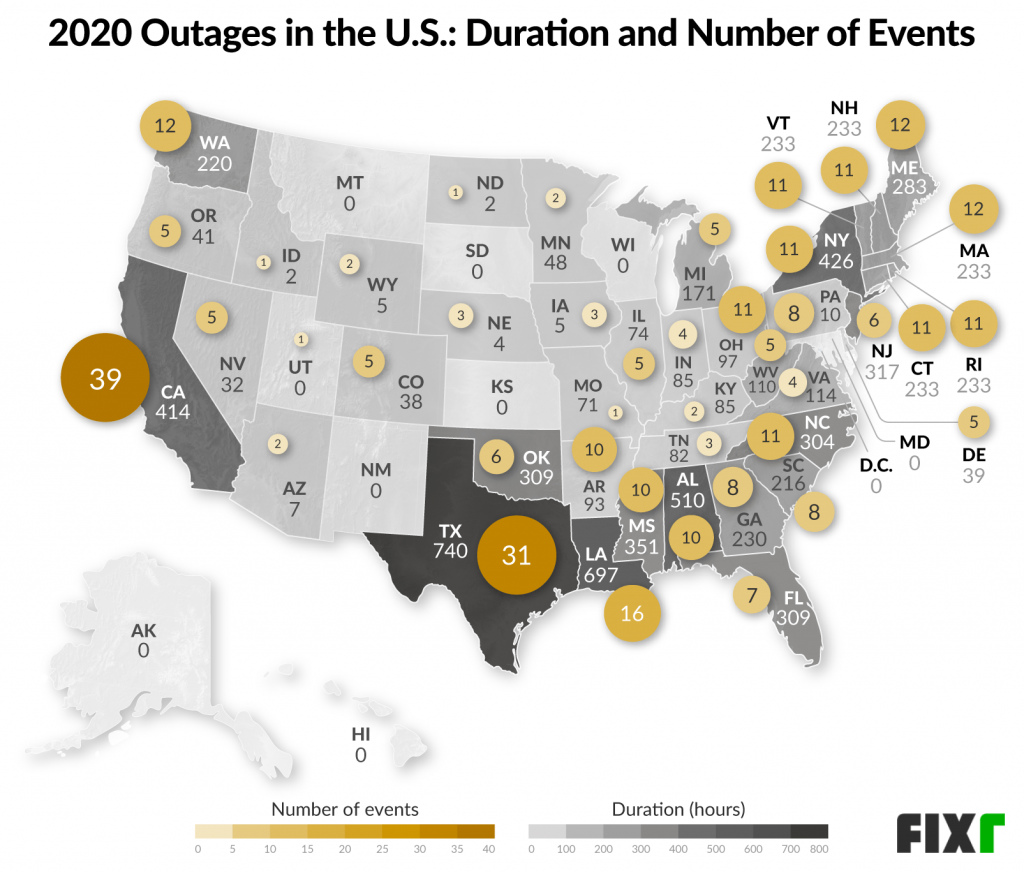Energy storage systems (ESS) are essential additions to your home energy system, such as your solar panel array. They are flexible storage systems that allow you to store your solar electricity and use it or sell it later. In addition, they are also reliable UPS backups in the event of a power outage.
Tesla’s Powerwall is one of the best ESS on the market regarding robustness, building quality, and warranty.
When buying this storage solution, the first question that might come to your mind is: what is the capacity of a Tesla Powerwall?
Fortunately for you, that’s what we’re here to answer!
In doing so, we’ll determine what you can run with a Tesla Powerwall and if its capacity is sufficient to power your house during a power outage.
Are you tempted to live off-grid? Let’s see if Tesla Powerwalls capacity is enough for your needs.
Table of Contents
What Is The Capacity Of A Tesla Powerwall?
A Tesla Powerwall has a capacity of 14kWh, of which 13.5kWh are usable.
In 2015, Tesla made history by introducing the first domestic energy storage solution. This announcement was a breakthrough.
Although Tesla didn’t invent lithium battery storage, they designed a Powerwall so user-friendly that adding an electricity storage system to your home becomes natural.
Since then, many alternatives to the Tesla Powerwall have popped up on the market, such as the LG Energy Solution. Still, Tesla remains one of the best options for storing electricity at home.
As discussed in our dedicated article, a battery’s capacity can be expressed either in Ah or kWh.
We will only be using kWh in this article as this unit is used to rate electricity consumption.
kWh = kW * hour
How Many Tesla Powerwalls Do I Need?
The Tesla Powerwall is an AC (alternating current) battery. It is a plug-and-play solution that you can connect directly to your home’s existing electrical system, even with no solar panels installed.
The Tesla Powerwall is capable of:
- Partially or fully powering your home during an outage;
- Storing solar energy for you to use whenever you like; and
- Complete energy independence (off-grid living).
To determine the number of Tesla Powerwalls you require, follow these four steps:
- Determine your daily electricity consumption
- Choose between a partial or a total backup system
- Select the backup time
- Do the math — calculate your number of Powerwalls
Determine Your Daily Electricity Consumption
How many kWh are you using in a day? To find out, look at your electricity bill.
Your electricity consumption is indicated in kWh. In the example below, the daily consumption is 32.9 kWh, slightly higher than American households’ average daily consumption (30 kWh).

Source: Edison
Choose Between A Partial Or Total Backup System
A Tesla Powerwall’s most significant feature is that it’s an AC battery. This makes it very easy to install anywhere in your house.
Because of this, you can connect it to your whole house electrical system for complete backup or only to your essential appliances (such as AC, refrigerator and freezer, light, etc.) for partial backup.
Select The Power Backup Duration
Extreme climatic events and weak energy grid resilience are leading to an increasing number of power outages.
In the figure below, Texas, California, and Louisiana are the most affected. For example, in 2020, the power was interrupted in Texas on 31 occasions for a total of 740 hours.

In 2022, hundreds of power outage events are still being recorded by the US Energy Information Agency. Here are two recent examples:
| Location | Duration | Number of people affected |
|---|---|---|
| Memphis, Tennessee | 106 hours | 255,000 |
| North and South Carolina | 31 hours | 142,000 |
Luckily, most of the power outages last less than 2 hours.
Nevertheless, we recommend having at least 10 hours’ worth of backup power in case of an outage; this is enough to cover 90% of all power interruptions.
Calculate The Number Of Tesla Powerwalls You Need
Let’s do the math for an average American household:
- Daily electricity use: 30kWh
- Total household backup
- Backup time: 10 hours
Use the formula below:

In this scenario:
(30 x 10/24) / 13.5 = 0.92
One Tesla Powerwall would be enough to power an average US household for 10 hours in the event of a power outage.
Here are the number of Tesla Powerwalls you’ll require for various consumption levels and backup periods:
| Daily electricity use (kWh) | Backup time (h) | Powerwall |
|---|---|---|
| 30 | 10 | 1 |
| 40 | 12 | 2 |
| 40 | 24 | 3 |
| 50 | 10 | 2 |
Does A Powerwall Have Enough Capacity To Run An Aircon?
A Powerwall has enough capacity to run all types of aircon units for at least a full day (24 hours).
The following chart shows the most common aircon units in the U.S. and their running time on a single Powerwall.
| Aircon Power | Aircon BTU | Monthly electricity use (kWh) | Daily electricity use (kWh) | Running hours with Powerwall |
|---|---|---|---|---|
| 0.75 HP (550W) | 5,000 | 55 | 1.8 | 180 |
| 1 HP (735W) | 9,000 | 83 | 2.7 | 120 |
| 1.5HP (1100W) | 12,000 | 107 | 3.5 | 92 |
| 2HP (1440W) | 18,000 | 177 | 5.8 | 55 |
| 3.5HP (2500W) | 24,000 | 228 | 7.5 | 43 |
Please note: in this scenario, the aircon unit is the only load connected to the Powerwall.
Does A Powerwall Have Enough Capacity To Run A Refrigerator?
A Powerwall has enough capacity to run all types of refrigerators for at least 7 straight days.
The following chart will help you determine how long your refrigerator will run when powered by a single Powerwall.
| Refrigerator size (cubic feet) | Yearly electricity use (kWh) | Daily electricity use (kWh) | Daily electricity use (kWh) |
|---|---|---|---|
| 18-19 | 480 | 1.3 | 250 |
| 21 | 510 | 1.4 | 231 |
| 22-24 | 635 | 1.74 | 186 |
| 28 | 739 | 2.02 | 160 |
The Powerwall demonstrates its large storage capacity by running even the largest refrigerator (28 cubic feet) for an entire week (7 days).
Please note: in this scenario, the refrigerator is the only appliance connected to the Powerwall.
How Much Capacity Do I Need To Live Off-Grid With A Powerwall?
To successfully live off-grid, you’ll require a minimum storage capacity of 10 kWh. That’s equivalent to 1 Powerwall unit (13.5kWh).
In an off-grid scenario, the goal is to cover 100% of your electricity needs through your own energy production. The most common way of achieving this is to install a solar system coupled with a solar battery.
Well, the Tesla Powerwall is a solar battery.
A solar battery, such as the Powerwall, is a short-term storage unit. In other words, it can store your electricity anywhere from 24 hours to a few days.
The rule of thumb to sizing your battery when living off-grid is to cover at least 1 full day of average electricity use.
Living off-grid doesn’t necessarily mean reducing your level of comfort. With the latest technologies, all types of off-grid living are possible, from a secluded cabin to a modern household.
Let’s illustrate by looking at two scenarios:
How Many Powerwall Units For Off-Grid Cabin (No Aircon)
Let’s consider a small cabin for 4 people without aircon:
| Appliances | Power (W) | Hours of use per day (h) | Energy use (kWh) |
|---|---|---|---|
| 4 electric fans | 70 | 8 | 2.24 |
| TV | 110 | 5 | 0.55 |
| 10 Lights | 70 | 7 | 0.49 |
| Water pump | 1100 | 1 | 1.1 |
| Refrigerator (21cubic feet) | 120 | 24 | 1.4 |
| Other kitchen appliances | 500 | 0.5 | 0.25 |
| Laptop/phone | 150 | 5 | 0.75 |
| Stovetop (induction) | 1800 | 1 | 1.8 |
The total daily electricity consumption for an off-grid cabin is 8.58kWh; we can round it to 9kWh.
In that scenario, one Powerwall unit (13.5kWh) is enough to cover energy needs for 1 and a half days.
How Many Powerwall Units For Off-Grid Modern House ( with Aircon)
Now, let’s consider a modern household for 4 people with aircon:
| Appliances | Power (W) | Hours of use per day (h) | Energy use (kWh) |
|---|---|---|---|
| 3 TVs | 110 | 5 | 1.65 |
| 15 Lights | 105 | 7 | 0.735 |
| Water pump | 1500 | 1.5 | 2.25 |
| Refrigerator (28cubic feet) | 190 | 24 | 2.02 |
| Other kitchen appliances | 500 | 1 | 0.5 |
| Laptop/phone | 150 | 5 | 0.75 |
| Stovetop (induction) | 1800 | 1 | 1.8 |
| Electric stove | 2500 | 1 | 2.5 |
| 4 Aircon units | 1100 | 24 | 14 |
The total daily electricity consumption for an off-grid modern house is 26 kWh.
In this scenario, two Powerwall units (27 kWh) are enough to cover energy requirements for 1 day.
For more comfort and security, we recommend 3 Powerwalls (40.5 kWh); this will provide 1 and a half days’ worth of autonomy.
Final Thoughts
The Tesla Powerwall, with a capacity of 13.5kWh, is one of the largest domestic electricity storage units.
If you’re prone to power outages, this is an ideal solution; it can easily power your house for 10 hours, including your most powerful appliances such as the refrigerator and aircon.
Additionally, the Powerwall is designed to operate off-grid. We found out that one unit can power an entire small cabin. In contrast, two to three units are perfect for powering a larger off-grid house with modern appliances (AC, refrigerator/freezer, electric stove, TV, etc.).
Overall, the Tesla Powerwall is your best choice to enjoy off-grid living without sacrificing comfort.

